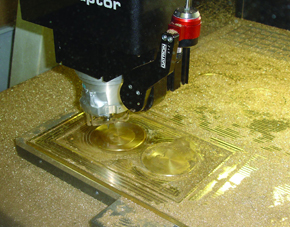Home >> Latest ArtCAM News >> Delcam’s ArtCAM gives Hallmark winning cards

Greeting card giant Hallmark combines hand engraving, digital design with Delcam’s ArtCAM Pro and high-speed machining to produce the dies for its vast selection of greeting cards. After changing from a nickel-forming process to digital manufacturing, the company now produces press-ready dies that are not only more consistent but are also less expensive to produce.
Hallmark represents roughly 50% of the greeting card market in the United States. Worldwide, the company employs more than 18,000 people, about 4,500 of whom work at its Kansas City, Missouri headquarters where the die design and manufacture occur.
Hallmark derives its strength from the talents of a creative staff of around 800 artists, designers, stylists, writers, editors and photographers. Together they generate more than 19,000 new and redesigned greeting cards and related products each year. Of this figure, over 11,000 cards require embossing or lettering using a custom die to produce a raised design.
A re-evaluation of the die-making process identified irregularities in surface finish and unpredictability in overall thickness and run quality. While the company decided that the expensive bench work had to go, the distinctive look of hand engraving had to stay.
The initial designs are still created in magnesium plates by Hallmark’s engravers, who have an average of 25 to 30 years’ experience. A proprietary data-capture process then imports the design into ArtCAM Pro, where the file undergoes tweaking by an engraving artist. The program then creates the NC code for the high-speed machining centres.
Senior artistic/digital engraver Rick Olsen is one of the digital artists that process the nearly 500 dies that pass through the computer-aided engraving department each month. Working from ArtCAM’s streamlined toolbox, he not only models a spectrum of designs but also generates toolpaths efficiently by applying predetermined milling strategies.
According to Mr. Olsen, the majority of the dies will not be re-machined. This means that generating the correct toolpaths in a timely fashion is essential. Equally important is the capability to simulate cuts in ArtCAM Pro prior to making them.
As made evident by Hallmark’s notable savings in the first year alone, the company’s strategy has paid off. A healthy portion of the immense savings can be attributed to one significant advantage of the new process – the precision fit being achieved.
"There was a noticeable variance when producing dies with the old method,” explained Phil Hammond, team leader of 3D reproduction at Hallmark. "In the past, we might have wasted hours levelling dies to produce uniformity. Now, we can supply manufacturing tools that fit very precisely, we can increase press speeds and achieve better quality with less effort.”
Hallmark has also limited the extent to which it outsources the machining of its dies. Thus the new process not only makes both the machining and the press work more efficient, but it also gives the company better response time and greater internal control.
This article is based on the feature story titled "Finding The Right Words And The Right Process" published in the June 2007 issue of Modern Machine Shop magazine, copyright 2007 Gardner Publications, Inc., Cincinnati, Ohio.
